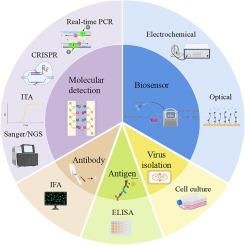Advances and challenges of mpox detection technology
IF 3
Q1 PUBLIC, ENVIRONMENTAL & OCCUPATIONAL HEALTH
引用次数: 0
Abstract
Mpox is a zoonotic disease caused by the monkeypox virus (MPXV). Diagnosing and treating the disease has become a global health concern requiring close attention to its spread to non-endemic regions. Clinical diagnosis is based on laboratory test results. Conventional detection techniques include real-time quantitative polymerase chain reaction (qPCR), genome sequencing, antigen and antibody identification, and virus isolation. Nevertheless, these methods fall short of rapidly and efficiently identifying MPXV, as they require specialized training, specific laboratory environments, and professional-grade equipment. Emerging technologies offer complementary advantages to meet diverse diagnostic needs, including various point-of-care testing (POCT) approaches and integrating biosensors with rapid detection techniques. This review discusses prospective future research avenues for MPXV detection, examining the advances and challenges of various detection techniques which may contribute to the ongoing elimination of mpox human-to-human transmission and serves as a reference for developing effective prevention and control strategies.

mpox 检测技术的进步与挑战
猴痘是一种由猴痘病毒(MPXV)引起的人畜共患疾病。该疾病的诊断和治疗已成为全球健康问题,需要密切关注其向非流行地区的传播。临床诊断以实验室检测结果为基础。传统的检测技术包括实时定量聚合酶链反应(qPCR)、基因组测序、抗原和抗体鉴定以及病毒分离。然而,这些方法需要专业培训、特定的实验室环境和专业级设备,因此无法快速有效地识别 MPXV。新兴技术具有互补优势,可满足不同的诊断需求,包括各种床旁检测(POCT)方法以及将生物传感器与快速检测技术相结合。本综述讨论了 MPXV 检测的未来研究方向,研究了各种检测技术的进展和挑战,这些技术可能有助于持续消除天花的人际传播,并为制定有效的预防和控制策略提供参考。
本文章由计算机程序翻译,如有差异,请以英文原文为准。
求助全文
约1分钟内获得全文
求助全文
来源期刊

Biosafety and Health
Medicine-Infectious Diseases
CiteScore
7.60
自引率
0.00%
发文量
116
审稿时长
66 days
 求助内容:
求助内容: 应助结果提醒方式:
应助结果提醒方式:


